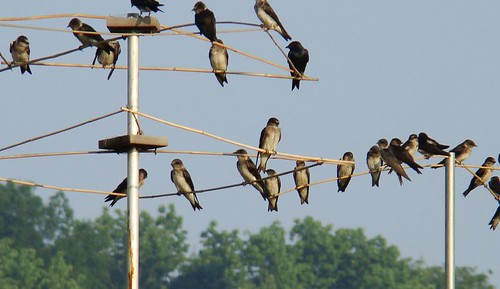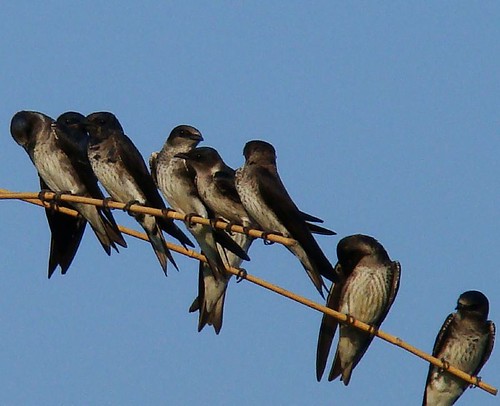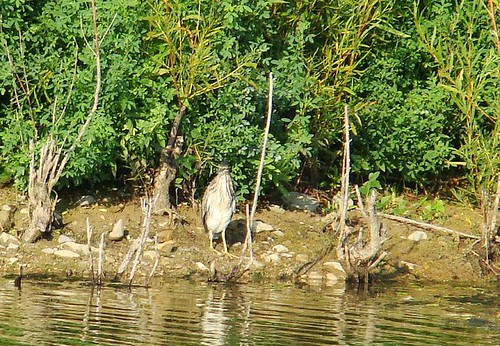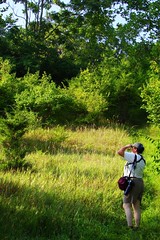If you want to read about my previous visit with Kathi, click here.
Debbie might just become a new birder friend. She is a self-proclaimed "newbie", but fun to hang out with. She put up with tons of chattering and babbling from Kathi and me.
(When it comes to the Flock, we are all like BFF with anyone we meet)
Let's just focus on what we saw (it wasn't much):

The day started hot and humid.
It continued with more hot and humid.
This place is stellar in the winter, just lousy with ring-necked ducks , both scaup species, mergansers, coots and grebes, a bald eagle has visited in previous years...just great stuff.
Summer....is rather boring.
Note: I didn't get a picture of it, but I saw a female Blue Grosbeak. I was the only one in the group who saw it, but I'm sure of the ID. Brown bird, huge conical bill, dark upperparts, paler underparts, darker wings and tail...sitting in a shrubby part of the preserve.
I have poured over pictures, habitat and range maps...LIFER! Number 220~
Grand Valley is rather proud of their Purple Martin colony...they ended last year with 35 nestlings, and this year, they counted 135 nestlings!
Jeez. I can't get one PAIR to nest in my yard.

We saw many, many, many PUMA...the power lines were thick with them. Hundreds and hundreds and hundreds of them. Wish I had thought to get a photo of the powerlines. You could see the blackness of all the PUMA from across the preserve.

Kathi's eagle eyes spotted a green heron across the way:

I think this is the first time I have seen one in sunlight. They are usually so skulky.

We kept hearing what sounded like a Field Sparrow with an 'accent'. The typical song of a FISP has a trill that goes up at the end, but this one was trilling down. A listen to the good ol' Birdjam (Hi, Jay!!!) confirmed a FISP.

Kathi goes Off-Road Birding.
(Girlfriend needs a tan)
This single tree, stretching out of the water inspired us to try to make up a haiku for it.
(You know, a poem with the formula of 5 syllables, then 7, then 5?)
It was too hot and muggy, so we never even got past the first line.

But sitting in the cool basement, I might be able to come up with something...
This tree small and wet
Mocks our panting and gasping
We are so sweaty.
:)

10 comments:
This is a birder blog. I expect birder talk; even sometimes abirder 'acronym' (with the definition in parentesis maybe). Imagine my surprise when I see here where she's helpfully explained what haiku is but leaves a blank space after the word 'PUMA'. I'm thinking a puma is a large tawny cat. As she's got it in all caps, I'm thinking it's a REALLY BIG CAT (one of my favorites); but I don't see it. I only see what appear to my untrained eye; are a bunch of swallows??
So I beg of you dear Susan, SPILL! (that's an acronym for us birder losers that means "please tell me wtf I'm lookin at")
**as you can see; we non-trained birders are lousy at making acronyms. :)**
LOL! Satcy!
Blue Grosbeak would be a MAJOR lifer for me...pout...
Stacy:
PUMA is the AOU (American Ornithology Association's) abbreviation for Purple Martin.
(You goofball)
Lynne:
Couldn't believe my luck...now I just need to see a MALE.
ROFLMFAO!!!
A American
O Ornithology
U = Assoc?
DUDE< they can't even get their own acronym right! Let's not even discuss PURPLE finches... We all know they are red! I think they just like to cause folks frustration; that way THEY are the ONLY one's who know anything!
so let's see if I have this right?
Purple
Underwater
Martin
Alliance
I meant "Union", not "association". Brain cramp.
Smart ass.
I saw a female Blue Grosbeak during my first fall birding trip to Cape May; still haven't seen a male, years later.
Oh well.
How cool to see all those PUMAs! The chirping must have been deafening. (I never attracted any to my houses this year either.)
PUMA = PUrple MArtin. Bird banders use codes for birds because there is too much to write down in a short time when you are banding a bunch of birds. I have seen 6-letter codes, but the 4 letter code is pretty much standard.
There are strict rules for the way the codes work. In a one-word bird name, like Killdeer, it is the first four letters of the word: KILL.
In a two-name bird, American Robin, it is the first two letters of each word: AMRO.
In a bird with a hyphenated name, Red-tailed Hawk, it is the first letter of each of the two hypenated words and the first two letters of the last word: RTHA.
Like most grammar rules, there are some exceptions.
More and more birders are adopting bander code when talking or writing about birds, at least, the easy ones. For example, if you are out birding with me, I will almost always call out "MODO!" when I see a MOurning DOve, but never "YBCU" for Yellow-billed Cuckoo.
Clear as mud?
PS: Yes, PUMA (Purple Martins) are some kind of swallow - the largest North American swallow, in fact. Very good, Stacy - watch out, or you will lose your non-birder status. Can you work out FISP later in the post? Hint is in there.
~Kathi
FIeld SParrow!! WHoot!!! GO ME!
and yes; I was like' oohhhhhhh' PUrple MArtin makes much more sense. I have to laff; RTHA; Aritha; always earn's respect in MY book! Thanks for the cool explaination! I really do appreciate it!
The swallow thing; it was the wings that made me think that. Though in watching the Planet Earth series; the Cave Swifts ( and I imagine the Chimney Swifts) those long flight feathers probably aren't the same family as Swallows either; (and certainaly not as colorful!
Post a Comment